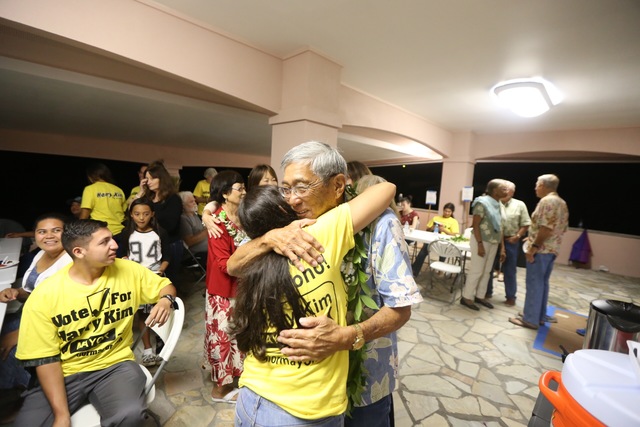Harry Kim has lost his West Hawaii problem. ADVERTISING Harry Kim has lost his West Hawaii problem. While favored most heavily on the windward side, Kim had no trouble winning votes in each corner of Hawaii Island in his landslide
Harry Kim has lost his West Hawaii problem.
While favored most heavily on the windward side, Kim had no trouble winning votes in each corner of Hawaii Island in his landslide victory during Saturday’s mayoral primary.
Islandwide, Kim won 51.6 percent of the vote, enough to declare him the outright winner in a crowded field of 13 candidates.
A Tribune-Herald analysis of votes by precinct showed the 76-year-old Hilo resident, who was mayor from 2000 to 2008, winning more votes from Naalehu through Hawi than his two closest competitors — Wally Lau and Pete Hoffmann — who reside in Kailua-Kona and Waikoloa, respectively.
That’s a reversal from the 2012 election when Kim, running against Mayor Billy Kenoi, was unable to close an East-West gap.
Both Hoffmann, a former County Council member, and Lau, a former managing director in Kenoi’s office, struggled to pull ahead outside of their hometowns.
Lau won five precincts and tied with Kim in another around Kailua-Kona and Kealakekua.
Hoffmann, meanwhile, came out on top in two precincts, one in Waikoloa and another in Holualoa.
Kim dominated outside those areas — winning 35 of 43 precincts — and he did it in trademark fashion.
“I don’t care how you cut it, that’s awesome,” he said, after being told the breakdown. “That really makes you feel good.”
Kim added that means “the burden is on you and you better carry the ball.”
Kim, who was Civil Defense chief for more than 20 years prior to his first term, relied heavily on name recognition and homemade signs from supporters.
As of July 29, he spent $10,248.94, according to the state Campaign Spending Commission. He also received the help from a couple unions that ran ads on his behalf.
Lau, who came in second with 25 percent of the vote, spent $184,954.47. That works out to $18.56 per vote for Lau and 49.7 cents per vote for Kim.
Lau said he knew name recognition was going to be a challenge.
“My role was to be behind the scenes” in the administration, he said. “As many people who knew me, five times as many people didn’t know who I was.”
Kim, who will take office in December, said he found his win almost hard to believe. He was expecting a general election matchup.
Announcing his candidacy early and sign waving more may have helped, Kim said.
The race also was overshadowed by Kenoi’s pending trial for misuse of his county purchasing card. The scandal likely gave Kim a boost since he is largely viewed as trustworthy.
Lau, who tried to distance himself from that issue, downplayed that as a factor.
“I really worked hard at not letting that get in the way of my message,” he said Monday.
“Although it was not the outcome we had hoped for, I’m very proud of how we ran the campaign,” Lau said.
Email Tom Callis at tcallis@hawaiitribune-herald.com.
Missing memory card delays vote count
Voting results for a Hilo precinct came in late during Saturday’s primary election after poll workers forgot a memory card used to keep track of votes cast through electronic voting machines.
Election workers realized the card was left at the polling site at Keaukaha Elementary School during an audit of equipment that evening, said Nedielyn Bueno, state Office of Elections spokeswoman.
Election observers accompanied a worker back to the polling place to retrieve it, she said.



